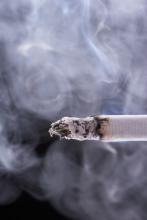DENVER – There’s a new reason to keep children away from secondhand smoke: It raises systolic blood pressure in boys, a University of Wisconsin, Madison, study suggests.
However, the mean increase was minimal – just 1.6 mm Hg – when researchers compared boys exposed to secondhand smoke with those who were not. "For an individual child, that’s not necessarily something you would worry about" in the short term, lead investigator and environmental health research fellow Jill Baumgartner, Ph.D., said the annual meeting of the Pediatric Academic Societies.
Still, elevated blood pressure in childhood can lead to adult hypertension and, "We found a similar [blood pressure] effect for children exposed to really low levels as for children exposed to higher levels, [reinforcing] the notion that there really is no acceptable exposure level for secondhand smoke," she said.
The study by Dr. Baumgartner and her colleagues is the first to demonstrate a link between secondhand smoke and blood pressure changes in children. Secondhand smoke already is known to decrease lung growth, increase the risk for sudden infant death, and cause respiratory problems in children, among other factors.
Conversely, however, Dr. Baumgartner and her colleagues also discovered that girls exposed to secondhand smoke had slightly lower systolic blood pressure than did other girls, a mean of 1.8 mm Hg.
"I think there could be something going on there, but we are not sure what it is," she said. "It’s actually supported in the academic literature" that smoking raises blood pressure in males but can have the opposite effect in females.
She hesitated to call female gender a protective factor, because the drop in blood pressure could signal some other deleterious effect of smoke exposure.
In their cross-sectional retrospective analysis, the researchers mined National Health and Nutrition Examination Survey data from 1999-2006, identifying 6,421 children aged 8-17, 52% girls, 34% white, 27% Mexican American, and about 32% exposed to secondhand smoke.
They defined exposure as having at least one smoker in the house and by serum cotinine levels of 0.01-14 ng/mL. Children with levels above 14 ng/mL were excluded because that level of the nicotine metabolite indicates that they themselves smoke. Having a smoker in the house strongly correlated with cotinine levels.
Through matching and statistical adjustments, the researchers controlled for a range of confounding variables, including age, sex, body mass index, physical activity, survey year, health insurance, household income, and potassium, caffeine, and sodium intake.
There was no dose-response relationship between cotinine levels and blood pressure. Elevations were similar in boys and drops similar in girls across cotinine levels. In exposed boys, increases in systolic blood pressure ranged from 1-1.9 mm Hg. In exposed girls, drops ranged from 1.5-2.6 mmHg. Results were statistically significant.
"If you looked at higher doses, you might see a dose response, but in this range of exposure, because it’s so low" it wasn’t apparent, Dr. Baumgartner said.
The next step is a longitudinal study to see whether blood pressure changes vary with variations in secondhand smoke exposure. "We are also trying to better understand the biologic drivers of tobacco smoke and blood pressure in kids," she said.
In the meantime, "If you are physician and have a parent coming in saying ‘I am reducing the amount I’m smoking,’ we are showing that’s not quite enough. [They] need to stop smoking, because even at really low levels, exposure is having an effect on kids and their blood pressure," she said.
Dr. Baumgartner said she has no disclosures. The study was funded by an Academic Pediatric Association Young Investigators Grant.


